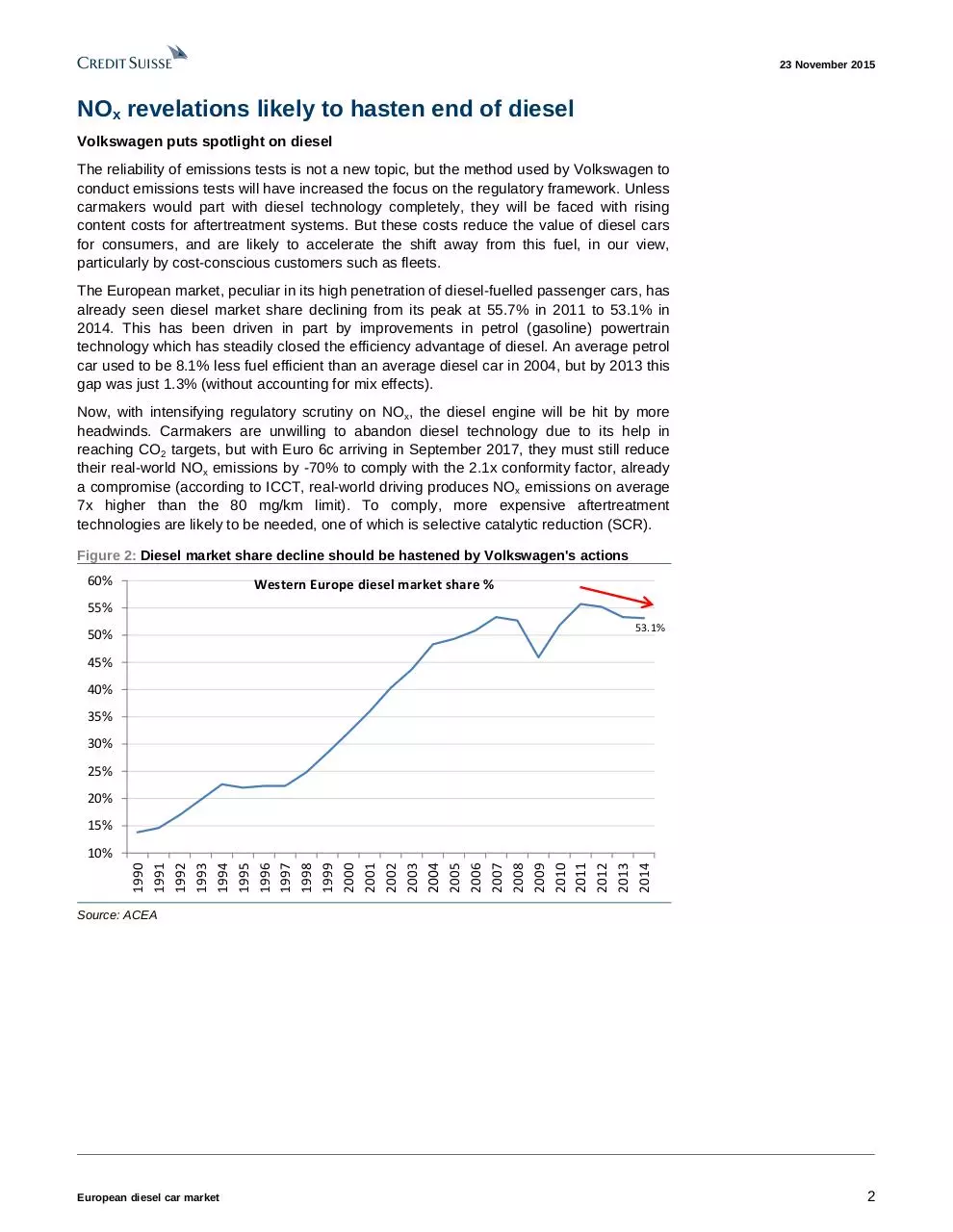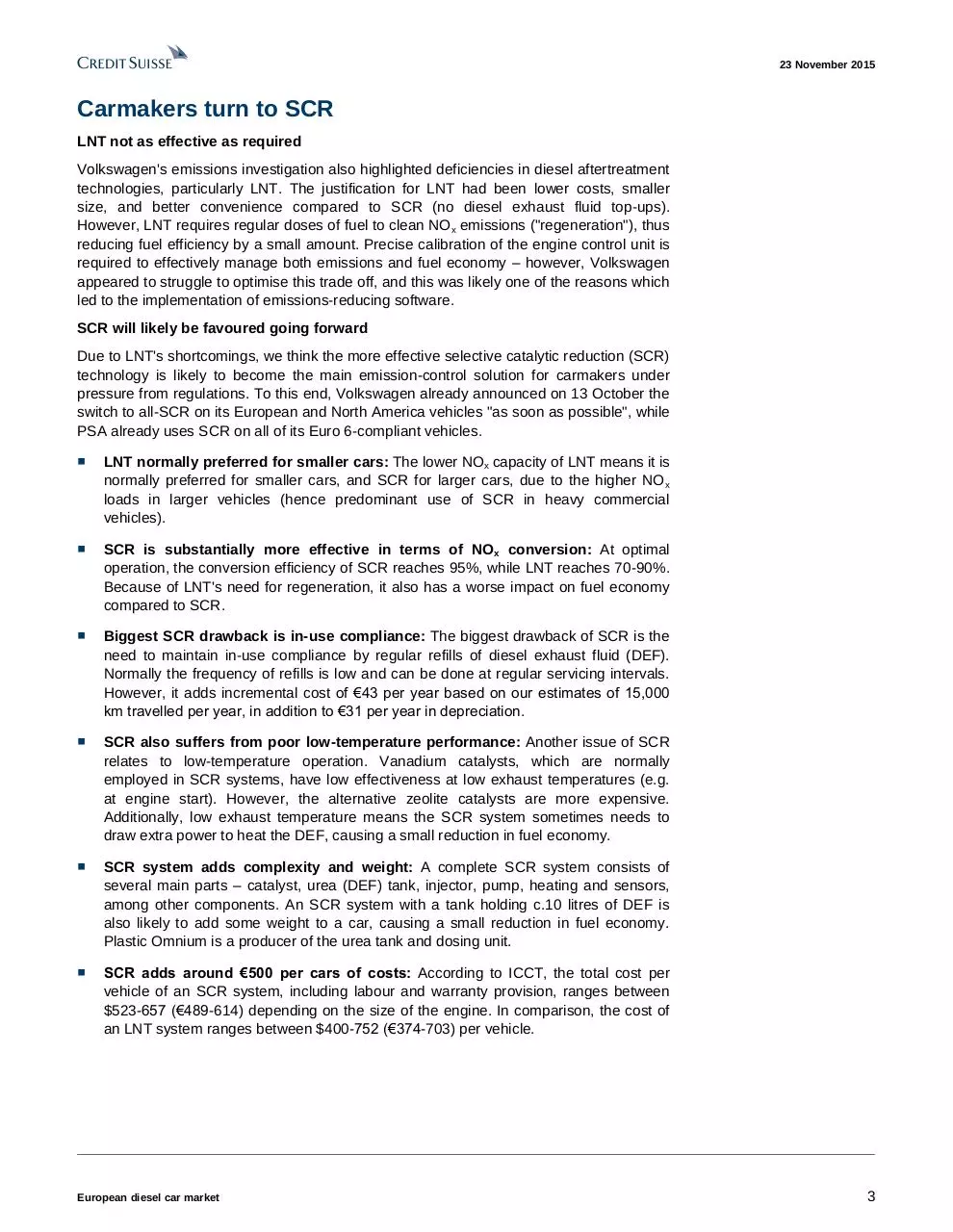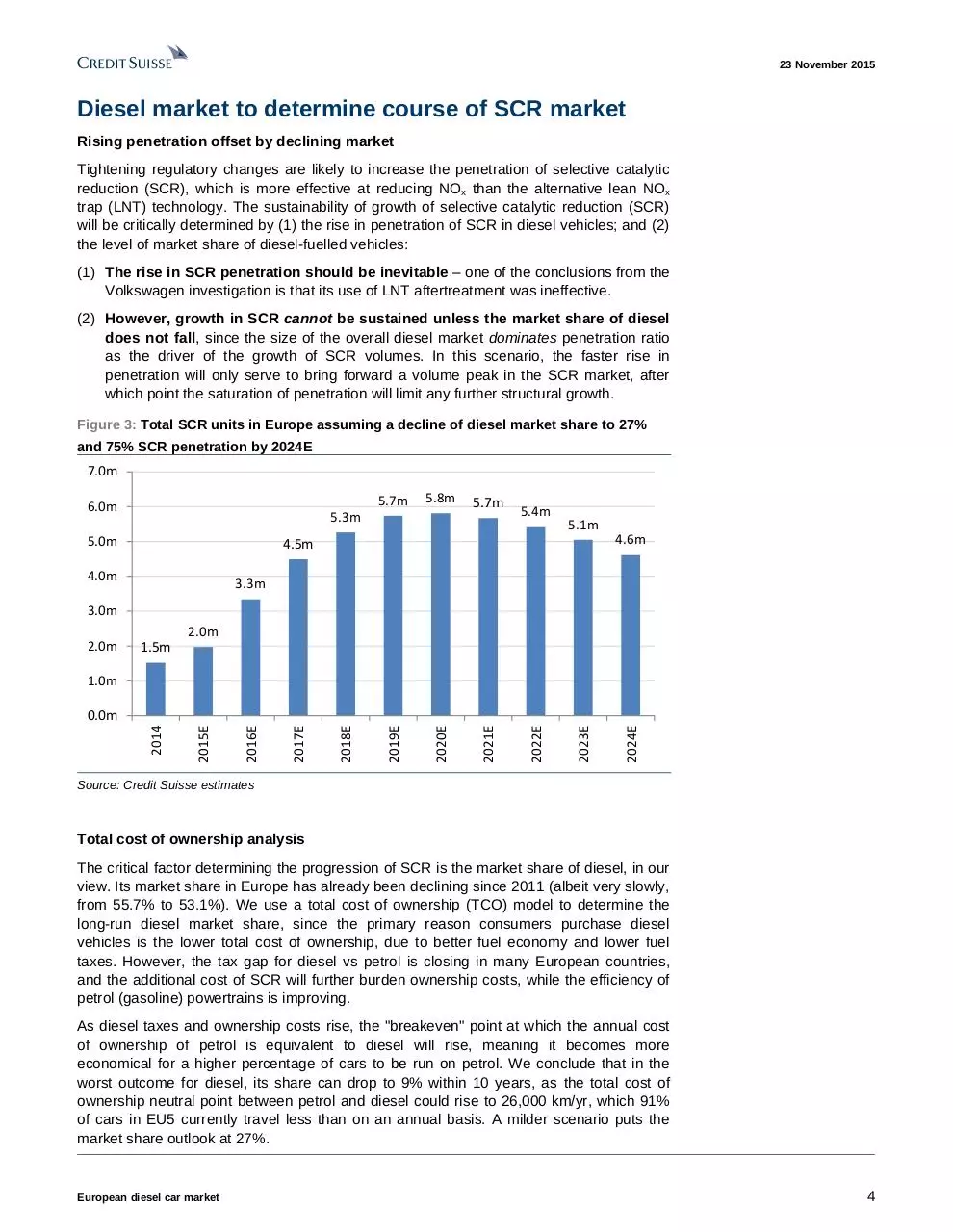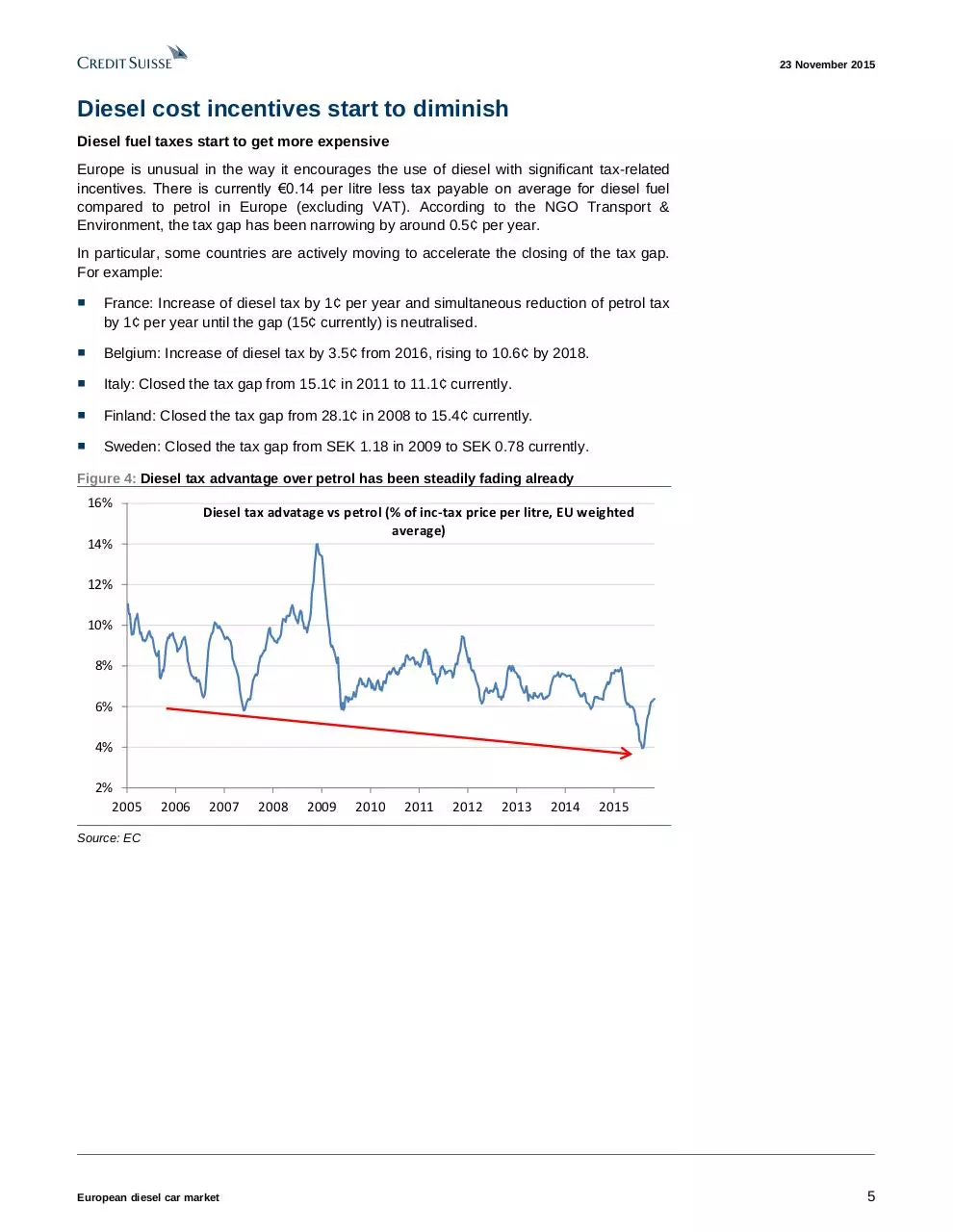Diesel endgame (PDF)
File information
Title: UNO Template
Author: Teng, Fei (VZDQ 411)
This PDF 1.5 document has been generated by Microsoft® Word 2010, and has been sent on pdf-archive.com on 19/07/2017 at 14:00, from IP address 217.111.x.x.
The current document download page has been viewed 459 times.
File size: 1.28 MB (29 pages).
Privacy: public file





File preview
23 November 2015
Europe
Equity Research
Auto Parts & Equipment (Automobiles & Components (Europe))
European diesel car market
Research Analysts
Fei Teng
44 20 7883 9978
fei.teng@credit-suisse.com
Alexander Haissl
44 20 7888 8507
alexander.haissl@credit-suisse.com
Stephanie MacAulay
44 20 7883 3958
stephanie.j.macaulay@credit-suisse.com
Specialist Sales: Andrew Bell
44 20 7888 0479
andrew.bell@credit-suisse.com
SECTOR REVIEW
Diesel endgame: single digit market share?
And why SCR growth is uncertain long term
■ Our scenario analysis suggests Europe diesel share could fall as low
as 9% within 10 years: Based on our total cost of ownership analysis, we
estimate diesel share could fall as low as 9% by 2024. This is driven by
increased aftertreatment component costs, diesel fuel taxes and
improvements in petrol powertrain efficiency. By 2024, we think it could be
more economical for any car in Europe driving less than 26,000 km/yr (91%
of cars) to be fuelled by petrol (gasoline). A more moderate scenario puts
diesel market share at 27% in 2024E.
■ Outlook for aftertreatment technologies uncertain: Selective catalytic
reduction (SCR) looks set to benefit from tighter emissions regulation, but
higher penetration ratio may ultimately be offset by a declining diesel market.
In effect, the volume peak in SCR may occur earlier than previously
anticipated if OEMs accelerate emissions control. However, growth looks
difficult to sustain unless the diesel market share can remain resilient.
■ Suppliers like Plastic Omnium (UP) set for short-term boost: Better
effectiveness of SCR compared to LNT is likely to boost penetration of SCR
technology. Plastic Omnium's SCR business is currently c. 2% of sales, but is a
key contributor to its overall revenue growth. We increase our target price to €20.
However, longer-term prospects remain uncertain as any material decline in
diesel share would immediately lead to the market for SCR to contract.
Figure 1: Western Europe diesel market share outlook
60%
Western Europe diesel market share %
Case 1
50%
50%
Case 2
40%
30%
27%
20%
Case 3
10%
9%
1990
1991
1992
1993
1994
1995
1996
1997
1998
1999
2000
2001
2002
2003
2004
2005
2006
2007
2008
2009
2010
2011
2012
2013
2014
2015E
2016E
2017E
2018E
2019E
2020E
2021E
2022E
2023E
2024E
0%
Source: ACEA, Credit Suisse estimates
DISCLOSURE APPENDIX AT THE BACK OF THIS REPORT CONTAINS IMPORTANT DISCLOSURES, ANALYST
CERTIFICATIONS, AND THE STATUS OF NON-US ANALYSTS. US Disclosure: Credit Suisse does and seeks to do
business with companies covered in its research reports. As a result, investors should be aware that the Firm may have a
conflict of interest that could affect the objectivity of this report. Investors should consider this report as only a single factor in
making their investment decision.
CREDIT SUISSE SECURITIES RESEARCH & ANALYTICS
BEYOND INFORMATION®
Client-Driven Solutions, Insights, and Access
23 November 2015
NOx revelations likely to hasten end of diesel
Volkswagen puts spotlight on diesel
The reliability of emissions tests is not a new topic, but the method used by Volkswagen to
conduct emissions tests will have increased the focus on the regulatory framework. Unless
carmakers would part with diesel technology completely, they will be faced with rising
content costs for aftertreatment systems. But these costs reduce the value of diesel cars
for consumers, and are likely to accelerate the shift away from this fuel, in our view,
particularly by cost-conscious customers such as fleets.
The European market, peculiar in its high penetration of diesel-fuelled passenger cars, has
already seen diesel market share declining from its peak at 55.7% in 2011 to 53.1% in
2014. This has been driven in part by improvements in petrol (gasoline) powertrain
technology which has steadily closed the efficiency advantage of diesel. An average petrol
car used to be 8.1% less fuel efficient than an average diesel car in 2004, but by 2013 this
gap was just 1.3% (without accounting for mix effects).
Now, with intensifying regulatory scrutiny on NOx, the diesel engine will be hit by more
headwinds. Carmakers are unwilling to abandon diesel technology due to its help in
reaching CO2 targets, but with Euro 6c arriving in September 2017, they must still reduce
their real-world NOx emissions by -70% to comply with the 2.1x conformity factor, already
a compromise (according to ICCT, real-world driving produces NOx emissions on average
7x higher than the 80 mg/km limit). To comply, more expensive aftertreatment
technologies are likely to be needed, one of which is selective catalytic reduction (SCR).
Figure 2: Diesel market share decline should be hastened by Volkswagen's actions
60%
Western Europe diesel market share %
55%
53.1%
50%
45%
40%
35%
30%
25%
20%
15%
1990
1991
1992
1993
1994
1995
1996
1997
1998
1999
2000
2001
2002
2003
2004
2005
2006
2007
2008
2009
2010
2011
2012
2013
2014
10%
Source: ACEA
European diesel car market
2
23 November 2015
Carmakers turn to SCR
LNT not as effective as required
Volkswagen's emissions investigation also highlighted deficiencies in diesel aftertreatment
technologies, particularly LNT. The justification for LNT had been lower costs, smaller
size, and better convenience compared to SCR (no diesel exhaust fluid top-ups).
However, LNT requires regular doses of fuel to clean NOx emissions ("regeneration"), thus
reducing fuel efficiency by a small amount. Precise calibration of the engine control unit is
required to effectively manage both emissions and fuel economy – however, Volkswagen
appeared to struggle to optimise this trade off, and this was likely one of the reasons which
led to the implementation of emissions-reducing software.
SCR will likely be favoured going forward
Due to LNT's shortcomings, we think the more effective selective catalytic reduction (SCR)
technology is likely to become the main emission-control solution for carmakers under
pressure from regulations. To this end, Volkswagen already announced on 13 October the
switch to all-SCR on its European and North America vehicles "as soon as possible", while
PSA already uses SCR on all of its Euro 6-compliant vehicles.
■
LNT normally preferred for smaller cars: The lower NOx capacity of LNT means it is
normally preferred for smaller cars, and SCR for larger cars, due to the higher NO x
loads in larger vehicles (hence predominant use of SCR in heavy commercial
vehicles).
■
SCR is substantially more effective in terms of NOx conversion: At optimal
operation, the conversion efficiency of SCR reaches 95%, while LNT reaches 70-90%.
Because of LNT's need for regeneration, it also has a worse impact on fuel economy
compared to SCR.
■
Biggest SCR drawback is in-use compliance: The biggest drawback of SCR is the
need to maintain in-use compliance by regular refills of diesel exhaust fluid (DEF).
Normally the frequency of refills is low and can be done at regular servicing intervals.
However, it adds incremental cost of €43 per year based on our estimates of 15,000
km travelled per year, in addition to €31 per year in depreciation.
■
SCR also suffers from poor low-temperature performance: Another issue of SCR
relates to low-temperature operation. Vanadium catalysts, which are normally
employed in SCR systems, have low effectiveness at low exhaust temperatures (e.g.
at engine start). However, the alternative zeolite catalysts are more expensive.
Additionally, low exhaust temperature means the SCR system sometimes needs to
draw extra power to heat the DEF, causing a small reduction in fuel economy.
■
SCR system adds complexity and weight: A complete SCR system consists of
several main parts – catalyst, urea (DEF) tank, injector, pump, heating and sensors,
among other components. An SCR system with a tank holding c.10 litres of DEF is
also likely to add some weight to a car, causing a small reduction in fuel economy.
Plastic Omnium is a producer of the urea tank and dosing unit.
■
SCR adds around €500 per cars of costs: According to ICCT, the total cost per
vehicle of an SCR system, including labour and warranty provision, ranges between
$523-657 (€489-614) depending on the size of the engine. In comparison, the cost of
an LNT system ranges between $400-752 (€374-703) per vehicle.
European diesel car market
3
23 November 2015
Diesel market to determine course of SCR market
Rising penetration offset by declining market
Tightening regulatory changes are likely to increase the penetration of selective catalytic
reduction (SCR), which is more effective at reducing NOx than the alternative lean NOx
trap (LNT) technology. The sustainability of growth of selective catalytic reduction (SCR)
will be critically determined by (1) the rise in penetration of SCR in diesel vehicles; and (2)
the level of market share of diesel-fuelled vehicles:
(1) The rise in SCR penetration should be inevitable – one of the conclusions from the
Volkswagen investigation is that its use of LNT aftertreatment was ineffective.
(2) However, growth in SCR cannot be sustained unless the market share of diesel
does not fall, since the size of the overall diesel market dominates penetration ratio
as the driver of the growth of SCR volumes. In this scenario, the faster rise in
penetration will only serve to bring forward a volume peak in the SCR market, after
which point the saturation of penetration will limit any further structural growth.
Figure 3: Total SCR units in Europe assuming a decline of diesel market share to 27%
and 75% SCR penetration by 2024E
7.0m
5.7m
6.0m
5.8m
5.3m
5.0m
5.7m
5.4m
5.1m
4.6m
4.5m
4.0m
3.3m
3.0m
2.0m
2.0m
1.5m
1.0m
2024E
2023E
2022E
2021E
2020E
2019E
2018E
2017E
2016E
2015E
2014
0.0m
Source: Credit Suisse estimates
Total cost of ownership analysis
The critical factor determining the progression of SCR is the market share of diesel, in our
view. Its market share in Europe has already been declining since 2011 (albeit very slowly,
from 55.7% to 53.1%). We use a total cost of ownership (TCO) model to determine the
long-run diesel market share, since the primary reason consumers purchase diesel
vehicles is the lower total cost of ownership, due to better fuel economy and lower fuel
taxes. However, the tax gap for diesel vs petrol is closing in many European countries,
and the additional cost of SCR will further burden ownership costs, while the efficiency of
petrol (gasoline) powertrains is improving.
As diesel taxes and ownership costs rise, the "breakeven" point at which the annual cost
of ownership of petrol is equivalent to diesel will rise, meaning it becomes more
economical for a higher percentage of cars to be run on petrol. We conclude that in the
worst outcome for diesel, its share can drop to 9% within 10 years, as the total cost of
ownership neutral point between petrol and diesel could rise to 26,000 km/yr, which 91%
of cars in EU5 currently travel less than on an annual basis. A milder scenario puts the
market share outlook at 27%.
European diesel car market
4
23 November 2015
Diesel cost incentives start to diminish
Diesel fuel taxes start to get more expensive
Europe is unusual in the way it encourages the use of diesel with significant tax-related
incentives. There is currently €0.14 per litre less tax payable on average for diesel fuel
compared to petrol in Europe (excluding VAT). According to the NGO Transport &
Environment, the tax gap has been narrowing by around 0.5¢ per year.
In particular, some countries are actively moving to accelerate the closing of the tax gap.
For example:
■
France: Increase of diesel tax by 1¢ per year and simultaneous reduction of petrol tax
by 1¢ per year until the gap (15¢ currently) is neutralised.
■
Belgium: Increase of diesel tax by 3.5¢ from 2016, rising to 10.6¢ by 2018.
■
Italy: Closed the tax gap from 15.1¢ in 2011 to 11.1¢ currently.
■
Finland: Closed the tax gap from 28.1¢ in 2008 to 15.4¢ currently.
■
Sweden: Closed the tax gap from SEK 1.18 in 2009 to SEK 0.78 currently.
Figure 4: Diesel tax advantage over petrol has been steadily fading already
16%
Diesel tax advatage vs petrol (% of inc-tax price per litre, EU weighted
average)
14%
12%
10%
8%
6%
4%
2%
2005
2006
2007
2008
2009
2010
2011
2012
2013
2014
2015
Source: EC
European diesel car market
5
23 November 2015
Local authorities move to limit diesels in cities
While national treasuries are moving to increase relative tax rates on diesel fuel, local
authorities are moving to limit the use of diesel cars in major cities through the broad
implementation of low-emission zones (LEZ), which reduces the practicality of owning
diesel vehicles in certain areas.
■
Paris: intends to ban entry of pre-Euro 6 diesel cars from 2020 onwards, with ongoing
discussions to potentially ban all diesel cars.
■
London: intends to charge a fee (£12.50) for Euro 6 diesel cars entering low-emissionzone from 2016. Diesel parking surcharge in borough of Islington.
■
Madrid: city parking charges determined by level of NOx emissions in scheme
introduced in 2014.
■
Prague: only Euro 3 and above diesel vehicles allowed in low-emissions-zone from
2016, Euro 4 and above from 2018. Euro 1 and above for petrol cars.
■
Milan: only Euro 4 and above diesel vehicles allowed in city centre since 2011. Euro 1
and above for petrol cars.
■
Stuttgart: only Euro 4 and above diesel vehicles allowed in low-emissions-zone from
2012. Euro 1 and above for petrol cars.
Though many cities with low-emission zones have fairly lenient regulations limiting only
pre-Euro 4 cars, in our view this is likely to tighten over time. One consequence of this
could be in lowered residual values due to the lowered utility value of older diesel cars,
which could then in turn pressure new car prices and make it unprofitable to produce some
smaller diesel cars.
European diesel car market
6
23 November 2015
Total cost of ownership decides fuel choice
Taxes, SCR to burden diesel cost of ownership
In our view, the long-run diesel market share in Europe should be determined by the
relative costs of ownership of diesel cars compared with petrol cars. In the worst case
outcome for diesel-engine cars, we think market share could fall as low as 9% within 10
years in Europe if taxes rise, costs of aftertreatment components become burdensome,
and petrol cars' efficiencies improve. If fuel taxes do not rise as we expect, then the market
share of diesel cars could still fall to 27% due to aftertreatment component costs, based on
our estimates.
We think the cost of ownership of diesel will increase relative to petrol for three reasons:
■
Increased depreciation and running costs for aftertreatment systems (SCR): We
estimate that the additional capital cost of an SCR system amounts to €500 which
depreciates to zero over the vehicle lifetime. In addition, the cost of DEF adds €2.86
per 1,000 km based on Volkswagen's data.
■
Increasing in taxation on diesel fuel: We assume that the price of diesel would rise
significantly in France and Germany to reduce (but not eliminate) the current price gap
to petrol. In both countries, diesel is currently 17% cheaper than petrol. In Spain and
Italy (where the difference is less) we assume a smaller but material price increase,
and in the UK (where there is no difference) the smallest rise.
■
Improvement in relative fuel economy: From 2004 until 2013, the difference in fuel
economy between the average petrol car and the average diesel car fell from 8.1% to
just 1.3% in Europe. While this figure does not adjust for mix (hence diesel models are
still generally c. 20% more efficient than their comparable petrol counterparts), we
think efficiency gains on petrol vehicles can continue to drive a narrowing in this gap.
Diesel market share to fall as ownership costs rise
We expect the total cost of ownership (TCO) differential between petrol and diesel to
gradually narrow though not disappear since diesel engines are inherently more efficient
than petrol. However, the proportion of drivers for which petrol becomes the more
economically logical choice should increase.
In the case of higher diesel taxes, higher exhaust aftertreatment costs, and improved
petrol fuel economy, we estimate that cars in EU5 travelling annual distances below
26,000 km will have a lower cost of ownership using petrol rather than diesel. This
compares with 8,000 km/yr at current petrol efficiency and diesel costs. Since 91% of cars
in EU5 currently travel less than 26,000 km/yr based on distance travelled data, we expect
the economically logical market share for diesel in this scenario to thus drop to 9%. This
compares to 32% of cars which currently travel less than 8,000 km/yr.
Full explanation of methodology given page 9.
European diesel car market
7
23 November 2015
Worst outcome: diesel market share could fall as low
as 9%
In the most pessimistic outlook for the diesel market, we estimate that within 10 years, the
rise in total cost of ownership (TCO) will make it uneconomical for 91% of the cars in EU5
to run on diesel fuel. In a more moderate case, if we assume no change in the relative
taxation on diesel and petrol fuel (unlikely in our view), our TCO model still suggests a
27% long-run diesel market share compared with 53% currently.
Figure 5: TCO neutral point (km/yr) – the annual distance travelled at which point the cost per year is equal between
petrol and diesel, based on a VW Golf
Petrol scenario
Petrol
Petrol + 10% efficiency
Petrol
Petrol + 10% efficiency
Petrol
Petrol + 10% efficiency
Diesel scenario
Diesel
Diesel
Diesel + SCR
Diesel + SCR
Diesel + taxes + SCR
Diesel + taxes + SCR
Germany
7,000
9,000
9,000
13,000
12,000
22,000
France
7,000
9,000
9,000
14,000
12,000
23,000
UK
10,000
21,000
15,000
35,000
16,000
35,000
Spain
9,000
13,000
12,000
20,000
14,000
27,000
Italy
8,000
13,000
10,000
16,000
11,000
21,000
EU5
8,000
12,000
10,000
17,000
13,000
26,000
Spain
50%
72%
67%
91%
76%
96%
Italy
47%
75%
59%
86%
66%
93%
EU5
32%
55%
47%
73%
61%
91%
Source: Credit Suisse estimates
Figure 6: Percentage of cars whose annual km driven is below the TCO neutral point (%)
Petrol scenario
Petrol
Petrol + 10% efficiency
Petrol
Petrol + 10% efficiency
Petrol
Petrol + 10% efficiency
Diesel scenario
Diesel
Diesel
Diesel + SCR
Diesel + SCR
Diesel + taxes + SCR
Diesel + taxes + SCR
Germany
20%
28%
28%
52%
45%
83%
France
24%
35%
35%
53%
64%
90%
UK
40%
85%
67%
99%
72%
99%
Source: Credit Suisse estimates
Figure 7: If petrol engine efficiency improves by 10%, and diesel cars become subject to SCR costs and additional fuel
taxes, then the rise in TCO would make it uneconomic for 91% of EU5 cars to be run on diesel vs the current 32%
100%
91%
Petrol + 10% efficiency vs diesel + taxes + SCR
80%
73%
Petrol + 10% efficiency vs diesel + SCR
61%
60%
Petrol vs diesel + taxes + SCR
55%
Petrol + 10% efficiency vs diesel
47%
Petrol vs diesel + SCR
40%
32%
Petrol vs diesel
20%
EU5 weighted average km driven, cumulative % of cars
0%
0
5,000
10,000
15,000
20,000
25,000
30,000
35,000
Source: Company data, Credit Suisse estimates
European diesel car market
8
23 November 2015
Methodology: total cost of ownership analysis
Diesel cars, compared to gasoline cars, generally exhibit lower running costs due to better
fuel economy but higher capital cost due to more expensive engine technology. Thus, for
low annual mileage, petrol cars are more economic than diesel cars. The breakeven point
("TCO neutral point") determines the annual distance travelled above which diesel cars
are the more economical purchase.
We determine the petrol vs. diesel TCO neutral point under several scenarios using the
ubiquitous Volkswagen Golf as the reference vehicle.
■
Petrol scenario 1: Petrol (gasoline) engine at "official" fuel economy.
■
Petrol scenario 2: Petrol (gasoline) engine at 10% better fuel economy than "official"
figure. We make this assumption on the expectation that advancement of powertrain
technology will continue to erode the comparative fuel economy advantage of diesel
(as it has been doing already for some time).
■
Diesel scenario 1: Diesel engine at "official" fuel economy.
■
Diesel scenario 2: Diesel engine plus the cost of SCR aftertreatment technology
including urea fluid, assuming the car does not already contain such a system.
■
Diesel scenario 3: As scenario 2, but assuming that the tax advantage of diesel
narrows, such as is happening in France, Italy and several other countries (Figure 8).
Figure 8: Comparative fuel cost advantage of diesel
Diesel price (€c/l)
Petrol price (€c/l)
Difference
Germany
124.40
145.27
16.8%
France
120.60
140.82
16.8%
UK
161.87
155.46
-4.0%
Spain
118.88
128.96
8.5%
Italy
148.28
160.54
8.3%
12%
139.33
12%
135.07
1%
163.49
5%
124.82
5%
155.69
Diesel scenario 3: tax/surcharge increase %
Diesel scenario 3: price (€c/l)
Source: Company data, Credit Suisse estimates
To generate results we follow the parameters and conditions set out below:
■
■
Reference vehicle: New Volkswagen Golf Mk7 (2012 SOP). Prices from official
Volkswagen Germany site. We take the lowest base model in each fuel type to retain
comparability.
o
Petrol (gasoline) version: "Trendline" 1.2L TSI, €17,650; 4.9l/100km.
o
Diesel version: "Trendline" 1.6L TDI, €21,875; 3.8l/100km.
Depreciation: Straight-line to scrap value.
o
Gasoline: Over 14 years to €400
o
Diesel: Over 16 years to €500
■
SCR: Assume additional €500 in capital cost per car, to account for unit cost plus
relevant development and manufacturing costs. We assume this depreciates to zero
over the lifetime of the car. In addition, we assume running costs of urea fluid (DEF) at
€2.86 per 1,000km, based on VW figures.
■
Other ownership costs: Assume diesel model insurance is 4% more expensive than
for petrol (based on Germany insurance quotes); but all other cost differences (such
as maintenance) are negligible.
European diesel car market
9
Download Diesel endgame
Diesel endgame.pdf (PDF, 1.28 MB)
Download PDF
Share this file on social networks
Link to this page
Permanent link
Use the permanent link to the download page to share your document on Facebook, Twitter, LinkedIn, or directly with a contact by e-Mail, Messenger, Whatsapp, Line..
Short link
Use the short link to share your document on Twitter or by text message (SMS)
HTML Code
Copy the following HTML code to share your document on a Website or Blog
QR Code to this page

This file has been shared publicly by a user of PDF Archive.
Document ID: 0000626422.